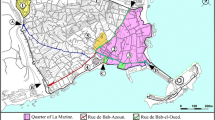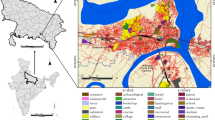Abstract
Low-lying islands and atolls are particularly prone to storm surges created by tropical depressions and typhoons. This paper presents a case study of traditional and contemporary settlement patterns of Majuro, the capital of the Republic of the Marshall Islands, and discusses its vulnerability to such storm surges. The paper shows that the application of traditional knowledge extends to the realm of urban planning and that, in fact, ignoring this traditional knowledge as expressed in pre-World War II settlement patterns, exposes urban development to increased flood hazards, a risk which may exact a price too high in life and property.
Similar content being viewed by others
Literature Cited
Alexander, D. E. 1993. Natural disasters. Chapman & Hall, New York.
Allessio, D. F. 1991. Economic survey of boat use and constructions costs of traditional Marshallese sailing outrigger canoes on Ailuk Atoll. Waan Aelon Kein Project Report No 6. Alele Museum, Majuro, Marshall Islands.
Barbina, G. 1979. The Friuli earthquake as an agent of social change in a rural area.Mass Emergencies 4(2):145–150.
Birdwell, K. R., and R. C. Daniels. 1991. A global geographic information system data base of storm occurrences and other climatic phenomena affecting coastal zones. ORNL/CDIAC-40. Carbon Dioxide Information Analysis Center, Oak Ridge National Laboratory, Oak Ridge, Tennessee.
Crocombe, R. 1988. Tomorrow's customary tenure in relation to conservation. Pages 21–28in P. E. Thomas (ed.), Report of the workshop on customary tenure, traditional resource management and nature conservation. Noumea, New Caledonia, 28 March–1 April 1988. South Pacific Environmental Programme, South Pacific Commission, Noumea.
Dahl, A. L. 1985. Traditional environmental management in New Caledonia: A review of existing knowledge. South Pacific Environmental Programme Topic Review 18. South Pacific Environmental Programme, South Pacific Commission, Noumea.
Dahl C. 1988. Traditional marine tenure, a basis for artisanal fisheries management.Marine Policy January 41–43.
Diacon, D. 1992. Typhoon resistant housing in the Philippines: The Core shelter project.Disasters 16(3):266–271.
Dupon, J. -F. 1984. Where the exception confirms the rule: The cyclones of 1982–1983 in French Polynesia.Disasters 8(1):34–47.
Emmanuel, K. A. 1987. The dependence of hurricane intensity on climate.Nature 326:483–485.
Erdland, P. A. 1905. Sturm auf Jaluit. Hiltruper Monatshefte 1905:447–449.
Erdland, P. A. 1906. Wörterbuch und Grammatik der Marshallsprache nebst ethnographischen Erläuterungen und kurzen Sprachübungen. Archiv Deutscher Kolonialsprachen, vol. IV. Georg Reimer, Berlin.
Erdland, P. A. 1914. Die Marshall Insulaner. Leben und Sitte, Sinn und Religion eines Südsee-volkes. Anthropos Bibliothik. Internationale Sammlung Ethnologischer Monographien, vol 2. Aschendorffsche Verlagsbuchhandlung, Münster.
Ginoza, L. 1979a. Majuro pounded by big surf. Pacific Daily News. 28 November 1979.
Ginoza, L. 1979b. Majuro damage into millions. Pacific Daily News. 29 November 1979.
Haque, C. E., and D. Blair. 1992. Vulnerability to tropical cyclones: Evidence from the April 1991 Cyclone in Coastal Bangladesh.Disasters 16(3):217–229.
Hawaii Architects and Engineers Inc. 1967. Planning proposals, Majuro Atoll, Marshall Islands District, Trust Territory Physical Planning Program, Second Submission. Hawaii Architects and Engineers, Inc., Honolulu.
Hawaii Architects and Engineers Inc. 1968a. Planning proposals, Majuro Atoll, Marshall Islands District. Trust Territory Physical Planning Program, Pre-Final Report. Hawaii Architects and Engineers, Inc., Honolulu.
Hawaii Architects and Engineers Inc. 1968b. Planning proposals, Majuro Atoll, Marshall Islands District. Trust Territory Physical Planning Program, Final Report. Hawaii Architects and Engineers, Inc., Honolulu.
Hawaii Architects and Engineers Inc. 1968c. Planning proposals, Ebeye and Carlson Islands, Marshall Islands District. Trust Territory Physical Planning Program, Final Report. Hawaii Architects and Engineers, Inc., Honolulu.
Hawaii Architects and Engineers Inc. 1972. Wotje master plan, Trust Territory of the Pacific Islands: Planning Division, Department of Public Works. Hawaii Architects and Engineers, Inc., Honolulu.
Holland, G. J., J. L. McBride, and N. Nicholls. 1988. Australian region cyclones and the greenhouse effect. Pages 438–456in G. I. Pearman (ed.), Greenhouse. Planning for a climatic change. E. J. Brill, London.
Hovertsen, P. 1979. Marshalls hit again. Pacific Daily News. 4 December 1979.
Jeschke, C. 1905. Bericht Über den Orkan in den Marschall-Inseln am 30. Juni 1905.Petermanns Mitteilungen 51:248–249.
Jeschke, C. 1906. Bericht Über die Marschall-Inseln.Petermanns Mitteilungen 52:270–277.
Johannes, R. E. 1986. Words of the lagoon. Fishing and marine lore in the Palau district of Micronesia. University of California Press, Berkeley.
Johannes, R. E. and J. W. MacFarlane. 1991. Traditional fishing in the Torres Strait Islands. CSIRO Division of Fisheries, Hobart, Tasmania.
Kiste, R. C. 1977. The relocation of the Bikini Marshallese. Pages 81–120in M. D. Lieber (ed.), Exiles and migrants in Oceania Association or Social Anthropology in Oceania Monograph 5. University of Hawaii Press, Honolulu.
Kreimer, A. 1979. Emergency, temporary and permanent housing after disasters in developing countries.Ekistics 46(279):361–365.
Kreimer, A. 1984. Housing reconstruction after major disasters as a vehicle of change.Ekistics 51(308):470–475.
Lewis, J. 1990. The vulnerability of small island states to sealevel rise: The need for Holistic change.Disasters 14(3):241–249.
Linckens, H. 1912. Auf den Marshall Inseln (Deutsche Sütdsee). Land und Leute. Katholische Missionsthätigkeit. Herz-Jesu Missionare, Hiltrup.
McCoy, J. J. 1981. Majuro development plan. High Commissioner of the Trust Territory of the Pacific Islands, Saipan, Marianas.
McHenry, D. F. 1975. Micronesia: Trust betrayed. altruism versus self-interest in American foreign policy. Carnegie Endowment for International Peace, New York.
Merz, G. 1912. Kaiserliches Bezirksamt Journal No. 5038/12. Report to the Imperial Governor at Rabaul, dated Jaluit, 16 May 1912. Ms. contained in Reichskolonialamt Volume 3077, document 5. Ms on file, Australian Archives Canberra, G-2, Y40.
Minor, J. 1984. The mode of construction as a determinant of the extent of cyclone damage to housing.Ekistics 51(308):463–468.
Mishra, D. K., and H. R. Prakash. 1982. An evaluation of the Andrah Pradesh cyclone shelters: Guidelines for the Orissa Programme.Disasters 6(4):250–255.
Mitchell, J. K. 1985. Prospects for improved hurricane protection on oceanic islands: Hawaii after Hurricane Iwa.Disasters 9(4):286–294.
Nordhoff, C. B., and J. N. Hall. 1936. The hurricane. Little, Brown, Boston.
Nucker, D. H. 1959. Census report 1958, Trust Territory of the Pacific Islands. High commissioner of the Trust Territory of the Pacific Islands, Agana, Guam.
OPS. 1989. Office of Planning and Statistics, Census of population and housing 1988. Final report. Office of Planning and Statistics, Majuro, Marshall Islands.
Pulea, M. 1988. Law, custom and development. Pages 29–32in P. E. Thomas (ed.), Report of the workshop on customary tenure, traditional resource management and nature conservation. Noumea, New Caledonia, 28 March–1 April 1988. South Pacific Environmental Programme, South Pacific Commission, Noumea.
Pulea, M., and Associates. 1985. Customary law relating to the environment. South Pacific Environmental Programme Topic Review 21. South Pacific Environmental Programme, South Pacific Commission, Noumea.
Richard, D. E. 1957. The United States Naval Administration of the Trust Territory of the Pacific Islands, vol 1: The wartime military government period 1942–1945. US General Printing Office, Washington, DC.
Rife, D. 1905. Letter dated 28 August 1905. Reprinted inMissionary Herald, September 1905, p. 469.
Rife, D. 1906. Letter. Reprinted inMissionary Herald, February 1906, p. 126.
Riley, T. J. 1987. Archaeological survey and testing, Majuro Atoll, Marshall Islands.In T. Dye (ed.), Marshall Islands archaeology. Pacific Anthropological Records 38. Department of Anthropology, Bernice P. Bishop Museum, Honolulu.
Schneider, D. M. 1957. Typhoons on Yap.Human Organization 16(2):10–14.
Schwabe, G. 1905a. Der Taifun auf Jaluit.Deutsche Kolonialzeitung 22:401–402.
Schwabe, G. 1905b. Ärztlicher Bericht für die Zeit vom 1 April bis 30 Juni 1905. Dated Jaluit, 1 September 1905.in Acta betreffend gesundheitliche Verhältnisse auf den Marshall Inseln von Juli 1903 bis Dezember 1906. Auswärtiges Amt. Kolonial Abteilung. Medizinalwesen 3h. File 5785. National Library of Australia, Canberra. Microfilm G 4785.
Scoble, S. 1982. The adaptation of a traditional African hut.Disasters 6(1):60–63.
Snarr, D. N., and E. L. Brown, 1978. Post-disaster housing in Honduras after Hurricane Fifi: An assessment of some objectives.Mass Emergencies 3(4):239–250.
Snarr, D. N. and E. L. Brown. 1979. Permanent post-disaster housing in Hondouras: Aspects of vulnerability to future disasters.Disasters 3(3):287–293.
Snarr, D. N., and E. L. Brown. 1980. User satisfaction with permanent post-disaster housing: Two years after Hurricane Fifi in Hondouras.Disasters 4(1):83–91.
Snarr, D. N., and E. L. Brown. 1982. Attrition and improvements: A study of post-disaster housing after three years.Disasters 6(2):125–131.
Snarr, D. N. and E. L. Brown. 1984. Disaster aid in Hondouras: The villager's point of view.Ekistics 51(308):483–487.
Snarr, D. N., and E. L. Brown. 1994. Post-disaster housing reconstruction: A longitudinal study of resident satisfaction.Disasters 18(1):76–80.
Spennemann, D. H. R. 1989. Local Polynesian rat traps: An evaluation of the performance of the coconut sling trap.Alafua Agricultural Bulletin (Western Samoa) 13(1):21–26.
Spennemann, D. H. R. 1992a. Cultural resource management plan for Majuro Atoll, Republic of the Marshall Islands. 2 vols. US Department of Interior, Office of Territorial and International Affairs, Washington, DC. Part I: Management Plan 543 pp. Part II: Appendices 352 pp.
Spennemann, D. H. R. 1992b. Historic demography of Majuro Atoll, Republic of the Marshall Islands.Journal of the Pacific Society 15(1):132–152.
Spennemann, D. H. R. 1992c. Makmok. Notes on the occurrence, utilisation, and importance of Polynesian arrowroot (Tacca leontopetaloides) in the Marshall Islands. Republic of the Marshall Islands Ministry of Internal Affairs/Ministry of Social Services Occasional Paper No. 1. Ministries of Internal Affairs and Social Services, Majuro, Marshall Islands.
Spennemann, D. H. R. 1993. Toorlok Bok (Predictions of environmental, economical, social and cultural impacts of a potential rise in relative sea-level on the atolls of the Marshall Islands, Micronesia). Pages 185–251in S. Burgin (eds.), Climate change: Implications for natural resource conservation. University of Western Sydney, Hawkesbury Occasional Papers in Biological Sciences 1. University of Western Sydney, Hawkesbury, Richmond, NSW.
Spennemann, D. H. R. 1996a. Marshall Islands.in P. Oliver (ed.), Blackwells encyclopedia of vernacular architecture of the world, vol 2, Cultures and societies. Blackwells, Oxford (in press).
Spennemann, D. H. R. 1996b. Nowhere to run. Effects of the typhoons of 1905 and 1918 on the atolls of the Marshall Islands. Johnstone Centre of Parks, Recreation and Heritage Report, The Johnstone Centre of Parks, Recreation and Heritage, Charles Sturt University, Albury, NSW (in preparation).
Spennemann, D. H. R., and I. C. Marschner. 1994. Stormy years: On the association between the El Niño/Southern Oscillation phenomenon and the occurrence of typhoons in the Marshall Islands. Report to the Federal Emergency Management Agency. Region IX. San Francisco. Johnstone Centre of Parks, Recreation and Heritage, Report No. 9. The Johnstone Centre of Parks, Recreation and Heritage, Charles Sturt University, Albury, NSW.
Spennemann, D. H. R., and I. G. Marschner, 1995. Association between ENSO and typhoons in the Marshall Islands.Disasters 19(3):194–197.
Spennemann, D. H. R., G. Byrne, and L. H. Belz. 1990. An outline of the potential impacts of greenhouse gas generated climatic change and projected sea-level rise on Tongatapu, Kingdom of Tonga. With special emphasis on the Nuku'a-lofa township area. Pages 161–192in G. Pernetta and P. J. Hughes (eds.), Implications of expected climate changes in the South Pacific region: An overview. United Nations Environmental Programme regional seas reports & studies series, vol 128.
Spoehr, A. 1949. Majuro, a village of the Marshall Islands.Fieldiana: Anthropology 39. Chicago Natural History Museum, Chicago.
Tonkinson R. 1979. The paradox of permanency in a resettled New Hebredean community.Mass Emergencies 4(2):105–116.
Treue, W. 1940. Der Erwerb und die Verwaltung der Marshall Inseln. Ein Beitrag zur Geschichte der Jaluit Gesellschaft. Unpublished PhD thesis. Friedrich Wilhems Universitet, Berlin.
US Army Corps of Engineers. 1969. Majuro airfield and related facilities. Preliminary engineering report. 1 October 1969. US Army Corps of Engineers, Honolulu.
US Army Corps of Engineers. 1989. Pacific Ocean division, Majuro Atoll coastal resource atlas. US Army Corps of Engineers, Honolulu.
Utanga, A. 1988. Customary tenure and traditional resource management in the Cook Islands. Pages 101–106in P. E. Thomas (ed.), Report of the workshop on customary tenure, traditional resource management and nature conservation. Noumea, New Caledonia, 28 March–1 April 1988. South Pacific Environmental Programme, South Pacific Commission, Noumea.
Wagner, P. 1979. Majuro blasted by waves.Pacific Daily News. 5 December 1979.
Wendland, W. M. 1977. Tropical storm frequencies related to sea surface temperatures.Journal of Applied Meteorology 16:477–481.
Author information
Authors and Affiliations
Rights and permissions
About this article
Cite this article
Spennemann, D.H.R. Nontraditional settlement patterns and typhoon hazard on contemporary Majuro atoll, Republic of the Marshall Islands. Environmental Management 20, 337–348 (1996). https://doi.org/10.1007/BF01203842
Issue Date:
DOI: https://doi.org/10.1007/BF01203842




